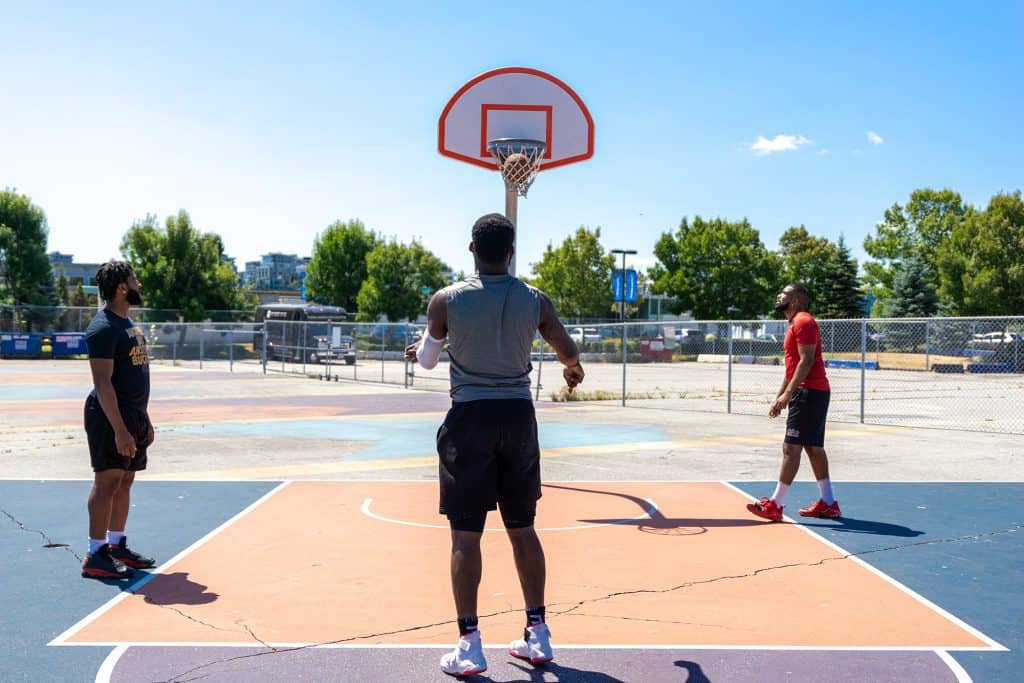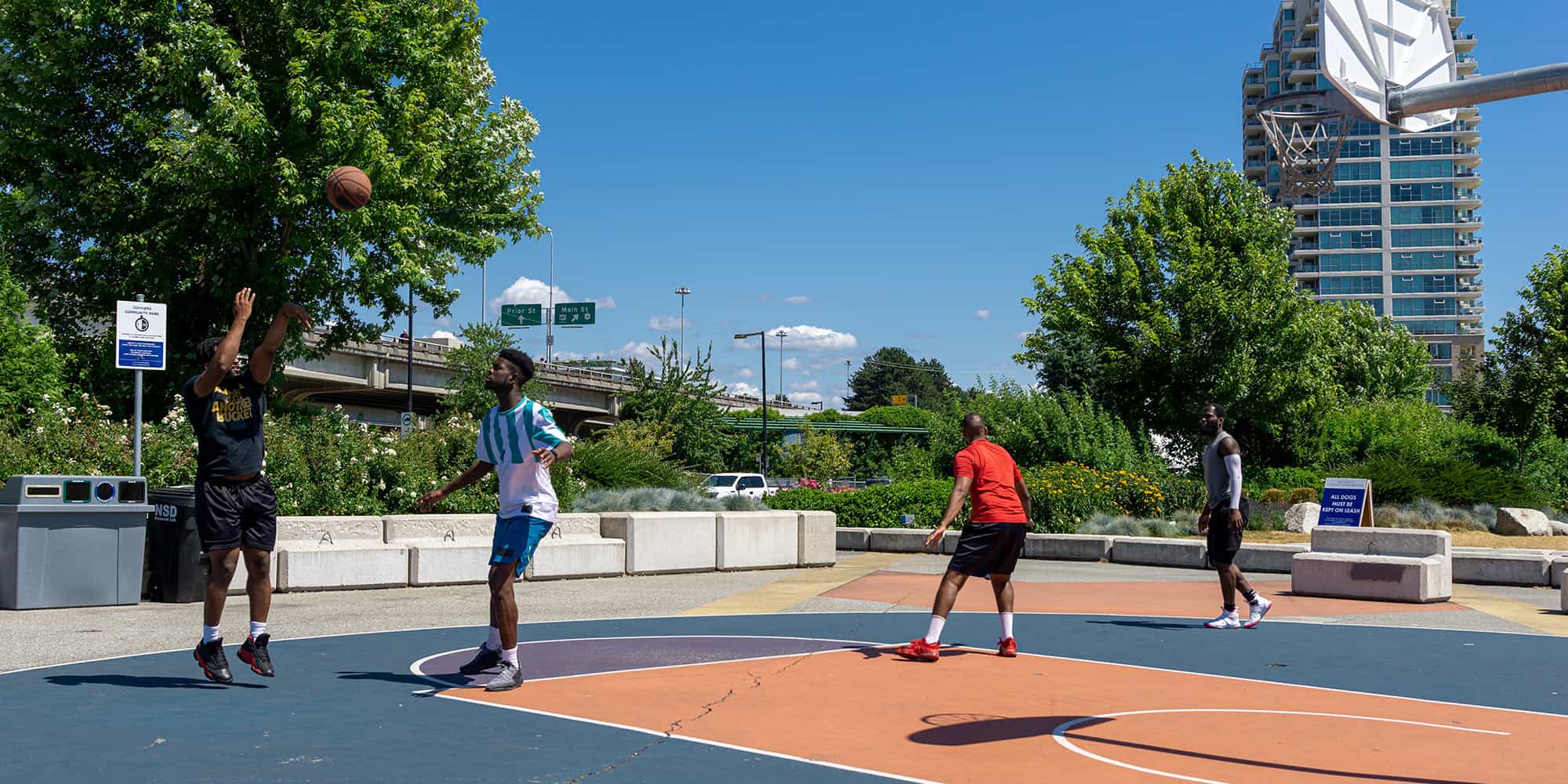So you want to learn how to play 21 in basketball? All you’ll need is a ball, one half of a basketball court, and a minimum of 3 players. Most times, 21 is a suggested streetball game if there are not the right number of players to play 3-on-3 (3×3 basketball) or 2-on-2 basketball. So let’s go ahead and cover the basics of playing 21.
The game 21 can be played at all levels and ages. No matter the skill level, it can work on several fundamental basketball skills. Some key focus points would be spot-up shooting, free-throw shooting, scoring against multiple defenders, and rebounding.
Important: Read First!
One very important thing to remember is that 21 basketball has many, many variations. While they are mostly regional variations, it’s very possible to find people from the same neighborhood arguing over differences in rulesets.
Therefore, an essential first step is to discuss the rules with the players you’ll be playing with. Discussing it beforehand will leave less room to argue if someone feels cheated later in the game.

Along with many different rules, twenty-one (21) also has a variety of names that people might use to refer to the same basketball game. If your opponents don’t know the game of 21, you can ask if they’ve ever played cutthroat, hustle, tip-it, noyceball, roughhouse, scutter, rough, or rebound. These alternative names of a game will provide a good reference point for them.
Universal Rules
- No teams, “one against all” basketball game
- First player to score exactly 21 points wins
Because there are a lot of other rules that can be added or removed to make the game easier or more complex, it’s crucial to understand the basic rules that apply to almost any variation of the game of 21.
First, there are no teams, 21 is a “one against all” basketball game. Every person acts as their own individual player, each trying to get to 21 total points before their opponents. This means that you’ll have multiple defenders playing defense against you while attempting to score. This can make it quite challenging, but don’t be discouraged, as you’ll still be teaming up with other players when you’re defending against the player in possession.
The first person to score precisely 21 total points wins the game, hence the name “21”. While the “exactly 21 points” is almost universal, there are some places where it’s a bit different. For example, in the West Los Angeles/UCLA variant of 21, you just need to score at least 21, and then score a free throw to seal the win.
Scoring System
- Field Goals are scored as (1’s and 2’s) or (2’s and 3’s)
- Free throw shots are worth 1 point each
The most common points system follows that of traditional basketball: Shots made inside the 3-point line are worth 2 points each, shots made from behind the 3-point line are worth 3 points each, and lastly, free throws are worth 1 point.
Another common way of scoring shots after the ball is live is to count one point for shots made inside the 3-point line or 2 points if a 3-pointer is made.

Play Area
- Play is (mostly) be restricted to the half-court
- The out of bounds rule is not enforced in 21 basketball, but be reasonable
With this point system in place, It’s essential to go over all areas on the court with your opponents.
For 21, we will be using the free-throw line, the three-point line, and the key. On a regulation basketball court, you will be able to find the free-throw line by measuring 15 feet out from the baseline. The 3 point line stretches further from the baseline and varies by court. If you are lucky enough to find yourself on an NBA court, you’ll find the line 23.75 ft from the basket, 22 feet in the corners of the court. You’ll most likely be playing on a court with a 3 point line set at 22.15ft and 21.65 in the corner, as these are the measurements for the FIBA and NCAA 3 point line. Lastly, it may be even a bit shorter, coming in at 19.75 ft at all points around the line (yes, even in the corners) for all high school gyms in the US.
The key is the rectangle-shaped box from the baseline to the free-throw line with the basket in the middle.
You may be asking, hey, what about the out-of-bounds lines? Most games will not be played with any out-of-bounds because there are multiple defenders, so it would be hard to determine who gets the ball after a turnover. With this being said, if the player or the ball goes out of bounds, you’ll usually just say “play-on!”.
Deciding Who Starts
- At the very beginning, decide on one player who will start using any method you want
- The winner of the game usually starts the next game when playing more than one game
Excellent; we know where the lines are, and we know how many points we can score from each area, now we’ll have to determine who gets the very first possession and commences play.
There are many ways you can decide. Draw straws, youngest starts, or closest birthday, are some simple methods that work well.
You can also do things like throw the ball, let it bounce two times, and let the first player to grab it start the possession. This simulates a jump ball. Or you could choose by shooting, and have everyone shoot a 3 or a free throw until one player makes a shot. They will start first.
The start is a fairly arbitrary aspect of 21, so don’t overcomplicate it.
The Game Loop
- The offensive player tries to score on everyone. Next, either (2), (3) or (4) will happen.
- Player takes a shot and misses:
- If a defender gets the rebound, the defender must “clear” and start a new possession (→1 with clear)
- If the offensive player gets their own rebound, they can continue play and attempt another shot (→1 without clear)
- Player takes a shot and scores:
- Take free throws – up to 3 – until one misses
- If any FT misses, the same rules as missing a normal shot apply (→2)
- If the player successfully hits 3 free throws in a row, they “clear” and start a new possession (→1 with clear)
- If there is a change of ball control, such as a turnover, a blocked shot, a steal, or a missed shot, the new player will “clear” and start a new possession (→1 with clear).
Explanation
The player who starts will receive the ball at the top of the 3 point line/top of the arc. They will start a dribble and begin attempting to score on all the opponents in the game, who will do their best to defend the ballhandler.
If the offensive player shoots the ball, all basketball players will battle for a rebound. If the player who shot the ball rebounds their own miss, they may continue playing and attempt another shot at the rim at any time.
However, if one of the defenders secures the rebound, they must dribble the ball outside of the 3 point line to reset the possession before scoring. Once they have reset the possession, they take their chance at attempting to score against the defenders, which now includes the player that just switched from offense to defense.
If the player with possession of the ball scores, they are rewarded with a chance to shoot a free throw. The defenders will line up in a rebounding position with an even number of players lining up on both sides of the key (the boxed area around the basket). If there are no lines drawn on the court to represent the key, have the players stand about opposite each other around 5 feet up from the baseline facing each other. The player who is “at the line” (shooting from the free-throw line) will get to take an undefended free throw. The shooter receives one point if they make a shot, and then they get to shoot another free throw. The maximum number of free throw shots the player can make is 3 in a row. This assumes we are playing using the “3 & Out” rule; if we are playing “threes all day” they can keep taking as many FTs as they want until they miss.
If this happens, they get to take the ball back behind the 3-point line to begin yet another offensive possession against the defenders. This rule is in place to prevent someone from making enough consecutive free throws to win the game.
If the player misses the free throw, the same rules as missing a normal shot apply. If a defender rebounds, they have to dribble outside the 3-point line before their offensive possession begins. If the free-throw shooter rebounds his own miss, he may attempt a shot at any time without taking it outside the 3-point line. Remember, if he recovers and scores after his own miss, it will count as 2 or 3 points because it was not a free throw.
One of the most important rules to remember is taking the ball beyond the 3 point line to reset the possession. Whenever there is a change of ball control, such as a turnover, a blocked shot, a steal, or a missed shot, the player with the ball must “clear” by dribbling behind the 3 point line. This resets the possession and allows the player with the ball to attempt to score.
The Win Condition
To win the game, you must reach precisely 21 points. You are not allowed to go over; this means you must understand how many points you have and attempt to score accordingly. Whether that’s from 18 points to 21 by scoring a 3 pointer. Or from 20 to 21 points if you score a free throw. If you make a shot that puts your score over 21, your score is reduced to whatever reduction score you’ve agreed on before the game, although this is usually 11.
Respect The Honor Code!
Because games of 21 are played casually, basketball rules are only loosely followed and people will rarely call out violations unless they are excessive. But as a player, you should be careful and try to avoid committing violations such as:
- Traveling
- Ups & Downs
- Double Dribble
- Fouling
The defense usually calls fouls, but be prepared if fouls aren’t called. 21 is known as a brutal game, so make sure to play accordingly. If too many fouls remain uncalled, you can switch to offense calls fouls. However, this can lead to too many calls being made. Whichever option you choose, try your best to respect the integrity of the game even if the opponents you’re playing against do not. Call your own fouls as reasonably as possible, so the basketball game is fun for everyone.
A Full Video Recording Of A 21 Basketball Game
Once you have a good idea of the rules of 21, it’s a good idea to watch a game of 21 before playing it yourself. Here’s a good video that shows a game of 21 basketball being played with fairly standard rules.
Notice how fluid everything is. When a player clears, they quietly dribble the ball outside the three-point line and automatically resume play. Unlike an officiated game with a referee blowing a whistle and making it clear what exactly is happening, things just flow naturally.
Variations
Understanding the basic ruleset above is essential. But you should be prepared to play with some of the most popular and heavily used rule variations, which stray from the regular rules.
In the wide world of hoops, there are a lot of different variations you may run into, and still, some players may bring up one you’ve never heard of.
It’s always important before starting the game to make sure all players are aware and playing with the same ruleset, and if you’re confused, never be afraid to ask for further clarification. Here are some of the most important ones to look out for.
Tips and Tip-Ins
The “wotring Rule,” “taps,” “tips” makes the game a bit more challenging but quite a bit more fun. If a defending player jumps to effectively “tap” a player’s shot into the hoop without touching the ground, it is referred to as being “tapped” or “tipped.” A penalty is applied to the player who shot the ball if this happens. This is generally resetting their score to 0 or 11 if their score is higher than 11 at that point in the game. Some players play by “stealing” five points from the player who shot and adding it to their own score.
Even more extreme, some rules call for eliminating the shooting player completely if their shot is tipped. This is usually if the player gets “tapped” while having 0 points, or if they have been “tapped” 3 times, or even if they are “tapped” by a player who only uses one hand. Once someone is eliminated, they’re usually able to re-enter the game if they catch any of the remaining player’s airballs.
Taking a Three Pointer instead of shooting Free Throws
In most games of 21, successfully scoring regular shots rewards the player with the opportunity to shoot up to three free throws. However, other variations call for a three-point shot to be made instead. This can speed up the game, with less time spent watching people take shots and more time with the ball in play. Often, scoring this three-point shot will only count as one point.
Penalizing Missed Winning Shots
If a player shoots for the win and misses, their score would be reduced to 15. This number can vary, and could instead be 11, 7, or even sometimes as low as 5 or 0. This is designed to make it harder to win and results in the basketball game lasting longer.
“Icing” The Winning Shot
End-of-game situations can vary. Some games of 21 require “icing” the win by making a final free throw or 3-point shot after reaching 21 points. If they miss, their score is reduced.

